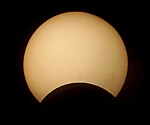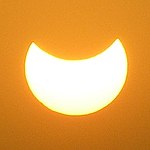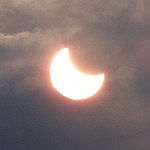Solar eclipse of October 3, 2005
| Solar eclipse of October 3, 2005 | |
|---|---|
 Annular from Madrid, Spain | |
 Map | |
| Type of eclipse | |
| Nature | Annular |
| Gamma | 0.3306 |
| Magnitude | 0.9576 |
| Maximum eclipse | |
| Duration | 272 sec (4 m 32 s) |
| Coordinates | 12°54′N 28°42′E / 12.9°N 28.7°E |
| Max. width of band | 162 km (101 mi) |
| Times (UTC) | |
| (P1) Partial begin | 3:53:56 |
| (U1) Total begin | 18:40:59 |
| Greatest eclipse | 10:32:47 |
| (U4) Total end | 1:22:35 |
| (P4) Partial end | 24:27:52 |
| References | |
| Saros | 134 (43 of 71) |
| Catalog # (SE5000) | 9520 |
An annular solar eclipse occurred at the Moon's descending node of the orbit on October 3, 2005, with a magnitude of 0.958. A solar eclipse occurs when the Moon passes between Earth and the Sun, thereby totally or partly obscuring the image of the Sun for a viewer on Earth. An annular solar eclipse occurs when the Moon's apparent diameter is smaller than the Sun's, blocking most of the Sun's light and causing the Sun to look like an annulus (ring). An annular eclipse appears as a partial eclipse over a region of the Earth thousands of kilometres wide. Occurring only 4.8 days after apogee (September 28, 2005), the Moon's apparent diameter was smaller. It was visible from a narrow corridor through the Iberian peninsula and Africa. A partial eclipse was seen from the much broader path of the Moon's penumbra, including all of Europe, Africa and southwestern Asia. The Sun was 96% covered in a moderate annular eclipse, lasting 4 minutes and 32 seconds and covering a broad path up to 162 km wide. The next solar eclipse in Africa occurred just 6 months later.
It was the 43rd eclipse of the 134th Saros cycle, which began with a partial eclipse on June 22, 1248, and will conclude with a partial eclipse on August 6, 2510.
Visibility[]
The path of the eclipse began in the North Atlantic ocean at 08:41 universal time (UT). The antumbra reached Madrid, Spain at 08:56 UT, lasting four minutes and eleven seconds and 90% of the Sun was covered by the Moon. The antumbra reached Algiers at 09:05 UT, then passed through Tunisia and Libya before heading southeast through Sudan, Kenya and Somalia. The shadow then moved out over the Indian Ocean until it terminated at sunset, 12:22 UT.[1]
The maximum eclipse duration occurred in central Sudan at 10:31:42 UT, where it lasted for 4m 31s when the Sun was 71° above the horizon.[1]
The motion of the shadow was supersonic and it generated gravity waves that were detectable as disturbances in the ionosphere. These gravity waves originate in the thermosphere at an altitude of about 180 km. Because of the obscuration of solar radiation, the ionization level dropped by 70% during the eclipse.[2][3] The eclipse caused a 1–1.4 K drop in the temperature of the ionosphere.[4]
Images[]


Satellite image showing the moon's shadow over East Africa

Animation from Medina del Campo, Spain

Santa Maria de Lamas, Portugal (9:00 UTC)
Eclipse projection through leaves in St. Julian's, Malta

Saintes, France (9:36 UTC)

Chennai, India (11:33 UTC)

Eclipse sequence from Degania A, Israel
Related eclipses[]
Eclipses of 2005[]
- A hybrid solar eclipse on April 8.
- A penumbral lunar eclipse on April 24.
- An annular solar eclipse on October 3.
- A partial lunar eclipse on October 17.
Tzolkinex[]
- Preceded: Solar eclipse of August 22, 1998
- Followed: Solar eclipse of November 13, 2012
Half-Saros[]
- Preceded: Lunar eclipse of September 27, 1996
- Followed: Lunar eclipse of October 8, 2014
Tritos[]
- Preceded: Solar eclipse of November 3, 1994
- Followed: Solar eclipse of September 1, 2016
Solar Saros 134[]
- Preceded: Solar eclipse of September 23, 1987
- Followed: Solar eclipse of October 14, 2023
Inex[]
- Preceded: Solar eclipse of October 23, 1976
- Followed: Solar eclipse of September 12, 2034
Solar eclipses 2004–2007[]
This eclipse is a member of a semester series. An eclipse in a semester series of solar eclipses repeats approximately every 177 days and 4 hours (a semester) at alternating nodes of the Moon's orbit.[5]
| Solar eclipse series sets from 2004–2007 | ||||||
|---|---|---|---|---|---|---|
| Ascending node | Descending node | |||||
| Saros | Map | Gamma | Saros | Map | Gamma | |
| 119 | 2004 April 19 Partial (south) |
-1.13345 | 124 | 2004 October 14 Partial (north) |
1.03481 | |
129 Partial from Naiguatá |
2005 April 08 Hybrid |
-0.34733 | 134 Annular from Madrid, Spain |
2005 October 03 Annular |
0.33058 | |
139 Total from Side, Turkey |
2006 March 29 Total |
0.38433 | 144 Partial from São Paulo, Brazil |
2006 September 22 Annular |
-0.40624 | |
149 From Jaipur, India |
2007 March 19 Partial (north) |
1.07277 | 154 From Córdoba, Argentina |
2007 September 11 Partial (south) |
-1.12552 | |
Saros 134[]
It is a part of Saros cycle 134, repeating every 18 years, 11 days, containing 71 events. The series started with partial solar eclipse on June 22, 1248. It contains total eclipses from October 9, 1428 through December 24, 1554 and hybrid eclipses from January 3, 1573 through June 27, 1843, and annular eclipses from July 8, 1861 through May 21, 2384. The series ends at member 71 as a partial eclipse on August 6, 2510. The longest duration of totality was 1 minutes, 30 seconds on October 9, 1428. All eclipses in this series occurs at the Moon’s descending node.[6]
| Series members 32–48 occur between 1801 and 2100: | ||
|---|---|---|
| 32 | 33 | 34 |
 June 6, 1807 |
 June 16, 1825 |
 June 27, 1843 |
| 35 | 36 | 37 |
 July 8, 1861 |
 July 19, 1879 |
 July 29, 1897 |
| 38 | 39 | 40 |
 August 10, 1915 |
 August 21, 1933 |
 September 1, 1951 |
| 41 | 42 | 43 |
 September 11, 1969 |
 September 23, 1987 |
 October 3, 2005 |
| 44 | 45 | 46 |
 October 14, 2023 |
 October 25, 2041 |
 November 5, 2059 |
| 47 | 48 | |
 November 15, 2077 |
 November 27, 2095 | |
Metonic cycle[]
The metonic series repeats eclipses every 19 years (6939.69 days), lasting about 5 cycles. Eclipses occur in nearly the same calendar date. In addition, the octon subseries repeats 1/5 of that or every 3.8 years (1387.94 days). All eclipses in this table occur at the Moon's descending node.
| 21 events between July 22, 1971 and July 22, 2047 | ||||
|---|---|---|---|---|
| July 21–22 | May 9–11 | February 26–27 | December 14–15 | October 2–3 |
| 116 | 118 | 120 | 122 | 124 |
 July 22, 1971 |
 May 11, 1975 |
 February 26, 1979 |
 December 15, 1982 |
 October 3, 1986 |
| 126 | 128 | 130 | 132 | 134 |
 July 22, 1990 |
 May 10, 1994 |
 February 26, 1998 |
 December 14, 2001 |
 October 3, 2005 |
| 136 | 138 | 140 | 142 | 144 |
 July 22, 2009 |
 May 10, 2013 |
 February 26, 2017 |
 December 14, 2020 |
 October 2, 2024 |
| 146 | 148 | 150 | 152 | 154 |
 July 22, 2028 |
 May 9, 2032 |
 February 27, 2036 |
 December 15, 2039 |
 October 3, 2043 |
| 156 | ||||
 July 22, 2047 | ||||
Notes[]
- ^ a b Espenak, Fred. "Annular Solar Eclipse of 2005 October 03". NASA/GSFC. Retrieved 2009-09-23.
- ^ Jakowski, N.; et al. (April 2008). "Ionospheric behavior over Europe during the solar eclipse of 3 October 2005". Journal of Atmospheric and Solar-Terrestrial Physics. 70 (6): 836–853. Bibcode:2008JASTP..70..836J. doi:10.1016/j.jastp.2007.02.016.
- ^ Šauli, P.; et al. (December 2007). "Acoustic–gravity waves during solar eclipses: Detection and characterization using wavelet transforms" (PDF). Journal of Atmospheric and Solar-Terrestrial Physics. 69 (17–18): 2465–2484. Bibcode:2007JASTP..69.2465S. doi:10.1016/j.jastp.2007.06.012.
- ^ Burmaka, V. P.; et al. (2007). "Tropospheric-ionospheric effects of the 3 October 2005 partial solar eclipse in Kharkiv". Kosmichna Nauka I Tekhnologiya. 13 (6): 74–86. Bibcode:2007KosNT..13f..74B. doi:10.15407/knit2007.06.074.
- ^ van Gent, R.H. "Solar- and Lunar-Eclipse Predictions from Antiquity to the Present". A Catalogue of Eclipse Cycles. Utrecht University. Retrieved 6 October 2018.
- ^ http://eclipse.gsfc.nasa.gov/SEsaros/SEsaros134.html
References[]
- Earth visibility chart and eclipse statistics Eclipse Predictions by Fred Espenak, NASA/GSFC
Photos:
- Photos of solar eclipse around the world
- Spaceweather.com solar eclipse gallery
- Annular Solar Eclipse at High Resolution APOD 10/5/2005, annularity from Spain
- Annular Eclipse Madrid APOD 10/7/2005, annularity from Buen Retiro Park, Madrid, Spain
- Annular Eclipse Shirt APOD 10/14/2005, from Madrid, Spain
| Wikimedia Commons has media related to Solar eclipse of 2005 October 3. |
- Annular solar eclipses
- 2005 in science
- 21st-century solar eclipses
- October 2005 events









